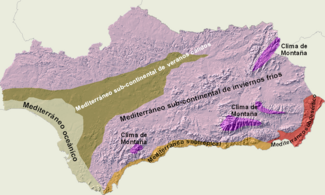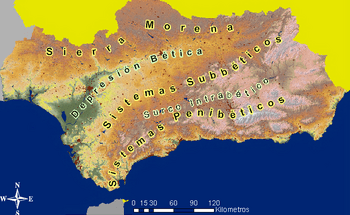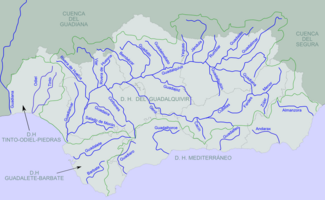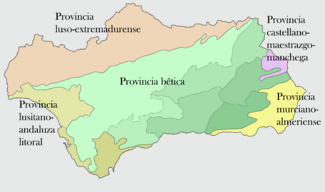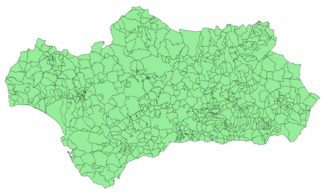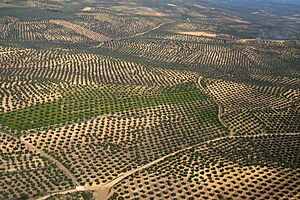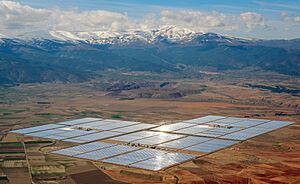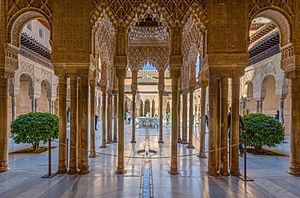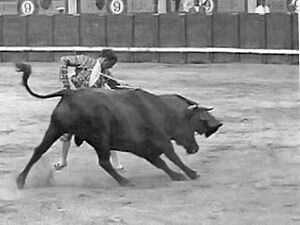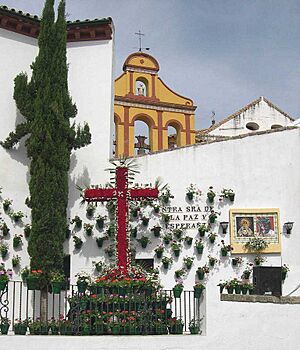Andalusia facts for kids
Quick facts for kids
Andalusia
Andalucía (Spanish)
|
|||
|---|---|---|---|
|
|||
| Motto(s):
Andalucía por sí, para España y la Humanidad
("Andalusia by itself, for Spain and humanity") |
|||
| Anthem: "La bandera blanca y verde" (English: "The White and Green flag") |
|||
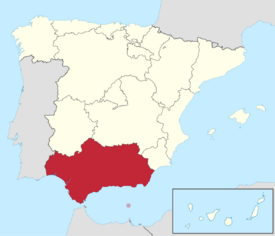
Map of Spain with Andalusia highlighted
|
|||
| Country | |||
| Formation | 1833 (Creation of Andalusia historic region) | ||
| Statute(s) of Autonomy | 1981 (First Statute) 2007 (Second Statute – in force) |
||
| Capital (and largest city) |
Seville | ||
| Province(s) | |||
| Government | |||
| • Type | Devolved government in a constitutional monarchy | ||
| • Body | Junta of Andalusia | ||
| Area | |||
| • Total | 87,599 km2 (33,822 sq mi) | ||
| Area rank | 2nd | ||
| 17.3% of Spain | |||
| Population
(1 January 2023)
|
|||
| • Total | 8,538,376 | ||
| • Rank | 1st 17.84% of Spain |
||
| Demonym(s) | Andalusian andaluz, -za |
||
| Official language(s) | Spanish | ||
| GDP | |||
| • Rank | 3rd | ||
| • Total (2022) | €180.224 billion | ||
| • Per capita | €21,091 (17th) | ||
| HDI | |||
| • HDI (2021) | 0.874 (very high · 14th) | ||
| Time zone | CET (UTC+1) | ||
| • Summer (DST) | CEST (UTC+2) | ||
| Postal code prefixes | |||
| ISO 3166 code | ES-AN | ||
| Telephone code(s) | +34 95 | ||
| Currency | Euro (€) | ||
| Official holiday | February 28 | ||
Andalusia (Spanish: Andalucía) is the southernmost autonomous community in Peninsular Spain. It's like a large region with its own government, located in the south of the Iberian Peninsula in southwestern Europe. Andalusia is the most populated and the second-largest autonomous community in Spain. It's officially recognized as a "historical nationality," meaning it has a unique history and culture.
The region is divided into eight provinces: Almería, Cádiz, Córdoba, Granada, Huelva, Jaén, Málaga, and Seville. Its capital city is Seville.
Andalusia is bordered by Extremadura and Castilla-La Mancha to the north. To the west, you'll find Portugal and the Atlantic Ocean. To the east, it borders Murcia and the Mediterranean Sea. To the south, it meets the Mediterranean Sea and the Strait of Gibraltar. Gibraltar, a British territory, shares a small land border with Cádiz province.
The main mountain ranges here are the Sierra Morena and the Baetic System. The Sierra Morena in the north separates Andalusia from other Spanish plains. In the south, the Baetic System includes the Sierra Nevada, home to Spain's highest peaks.
Andalusia has a rich culture. Many things people think of as typically Spanish, like flamenco music and dance, actually started here. The region also has a warm climate, especially in summer, with cities like Córdoba and Seville often reaching over 36°C (97°F).
Contents
What's in a Name? The Story of Andalusia
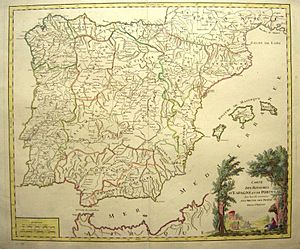
The name Andalusia comes from the Arabic word "Al-Andalus." This was the name for the parts of the Iberian Peninsula ruled by Muslims. The exact origin of "Al-Andalus" is debated. Some think it comes from the Vandals, a Germanic tribe, while others suggest it's from the Goths or even older Iberian tribes.
The Spanish name Andalucía started being used in the 13th century. At first, it referred to areas still under Muslim rule. Later, it was used for the lands Christians had taken back, especially in the Guadalquivir valley. Over time, the meaning of "Andalusia" changed, but it always referred to this southern part of Spain.
Symbols of Andalusia
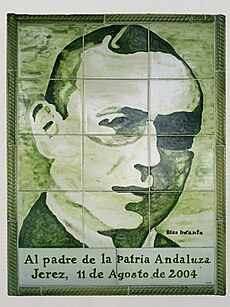
Andalusia has special symbols that represent its identity.
The Emblem
The Andalusian emblem shows Hercules standing between two pillars of Hercules. These pillars are traditionally thought to be on either side of the Strait of Gibraltar. Below Hercules, there's a banner with the Andalusian flag colors and the motto: Andalucía por sí, para España y la Humanidad ("Andalusia for herself, Spain and Humanity"). Above the pillars, a curved arch says in Latin: Dominator Hercules Fundator (Lord Hercules is the Founder).
The Flag
The official flag of Andalusia has three equal horizontal stripes: green, white, and green. The Andalusian coat of arms is in the middle. Blas Infante, often called the "Father of the Andalusian Nation," helped design the flag in 1918. He chose these colors because they were often used in the region's history. Green represents hope and a call for people to unite, while white stands for peace.
The Anthem
The anthem of Andalusia was composed by José del Castillo Díaz, with lyrics by Blas Infante. The music was inspired by an old religious song sung by farmers. The lyrics encourage Andalusians to work for "land and liberty" and for their region to have its own government within Spain.
Andalusia Day
Andalusia Day is celebrated every year on February 28. This day remembers the 1980 vote where people chose for Andalusia to become an autonomous community.
Geography of Andalusia
Andalusia is a large and diverse region. It covers about 87,597 square kilometers (33,821 square miles), which is 17.3% of Spain's total land. It's similar in size and variety to some smaller European countries.
Location and Borders
To the east, Andalusia is next to the Mediterranean Sea. To the west, it borders Portugal and the Atlantic Ocean. The Sierra Morena mountains form its northern border with central Spain. To the south, the Strait of Gibraltar separates it from Morocco.
Climate
Andalusia has a wide range of climates. It's home to some of the hottest and driest places in Spain, like Cabo de Gata, which gets very little rain. But it also has very wet areas, like inland Cádiz, where it rains a lot.
Generally, Andalusia has a hot-summer Mediterranean climate. This means hot, dry summers and mild, wet winters. However, the weather can change a lot depending on where you are. For example, you can go from the warm coast of Granada to the snowy peaks of the Sierra Nevada in just 50 kilometers!
The average temperature in Andalusia is over 16°C (61°F) per year. Cities like Córdoba and Seville are known for their very hot summers, often reaching over 40°C (104°F). The mountains, like the Sierra Nevada, are much colder and have snow almost all year.
Terrain
Andalusia's landscape is very varied, with mountains, valleys, and coasts. Mountains play a big role in shaping the climate, rivers, and even how people live.
- The Sierra Morena mountains in the north are not very high but form a natural border.
- The Baetic Cordillera in the south includes the Sierra Nevada, which has the highest peaks in Spain, like Mulhacén (3,478 meters or 11,411 feet).
- Between these mountain ranges is the Baetic Depression, a flat area where the Guadalquivir river flows. This has historically been the most populated part of Andalusia.
Rivers and Water
Andalusia has rivers flowing into both the Atlantic Ocean and the Mediterranean Sea.
- The Guadalquivir is the longest river in Andalusia. Rivers flowing into the Atlantic are usually long and run through flat areas, creating wetlands like the Doñana marshes.
- Rivers flowing into the Mediterranean are shorter and flow steeply from the mountains. They have less water because they are in a drier area.
Nature and Wildlife
Andalusia is home to many different plants and animals. Its typical vegetation is Mediterranean woodland, with trees like holly oaks and cork oaks. You'll also find pines and Spanish firs. Many areas have been changed by farming and wildfires, but there are efforts to protect the remaining forests.
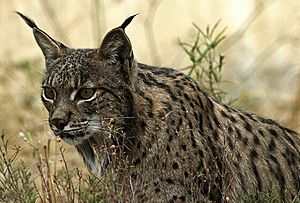
Andalusia is a very important place for animals. Over 400 of Spain's 630 vertebrate species live here. Because it's on the migration route between Europe and Africa, many birds pass through or live in Andalusia's wetlands. You can see flamingos, eagles, and vultures.
Large animals like the Iberian lynx and Iberian wolf are rare and protected. Smaller animals like rabbits are common and are a food source for many predators.
Protected Natural Areas
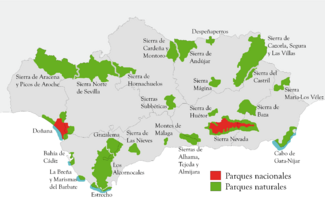
Andalusia has many special natural places that are protected. These areas are part of a network called RENPA, which includes national parks, natural parks, and nature reserves. Almost 20% of Andalusia's land is protected.
Some famous protected areas include:
- Sierras de Cazorla, Segura y Las Villas Natural Park: Spain's largest natural park.
- Sierra Nevada National Park: Home to Spain's highest mountains.
- Doñana National Park and Natural Park: A very important wetland for birds.
- Tabernas Desert: Europe's only desert.
- Cabo de Gata-Níjar Natural Park: A large protected area on the coast.
History of Andalusia
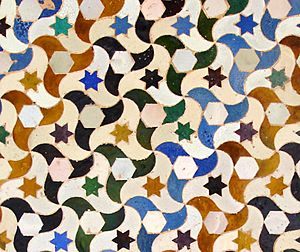
Andalusia's location, between Europe and Africa and between the Atlantic and Mediterranean, has made it a meeting point for many civilizations.
Ancient Times
From the Metal Ages, groups like the Phoenicians and Greeks settled here, drawn by minerals and fertile land. They influenced early cultures like Tartessos. Later, the Romans took over, making Andalusia a rich province called Baetica. Famous Roman emperors like Trajan and Hadrian came from this region. Even after the Vandals and Visigoths invaded, Roman culture remained strong.
Muslim Rule and Reconquista
In 711, Muslim armies arrived, and Andalusia became a key part of al-Andalus, the Muslim-controlled Iberian Peninsula. Córdoba became a major capital, known for its learning, science, and beautiful architecture during the Islamic Golden Age. However, by the 11th century, al-Andalus broke into smaller kingdoms called taifas. This allowed Christian kingdoms from the north to begin the Reconquista (reconquest).
By the late 13th century, much of Andalusia was taken back by the Crown of Castile. The last Muslim kingdom, Granada, fell in 1492, marking the end of Muslim rule in Spain.
Modern Era
After 1492, Andalusia played a huge role in Spain's exploration of the New World. Cities like Seville and Cádiz became important ports for trade with the Americas. However, the region later faced economic challenges. In modern times, Andalusia gained its status as an autonomous community in 1981, giving it its own government.
Government and Politics
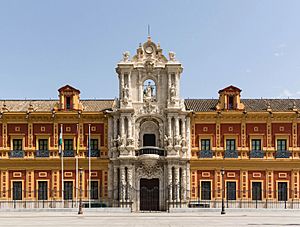
Andalusia is one of Spain's 17 autonomous communities. This means it has its own government, called the Junta de Andalucía. This government includes the Parliament of Andalusia and a president.
Andalusia became an autonomous community after a public vote on February 28, 1980. This was allowed by the Spanish Constitution of 1978, which gives regions the right to self-govern. The process was special because Andalusia had tried to gain autonomy before the Spanish Civil War.
The Andalusian Statute of Autonomy, which is like its own constitution, says that Andalusia is a "historical nationality." This recognizes its unique history and identity within Spain.
How Andalusia is Governed
The Junta de Andalucía is the main self-governing body. The President of Andalusia is the top leader, chosen by the King of Spain and approved by the Parliament. The Council of Government, led by the President, makes decisions and manages the region.
The Parliament of Andalusia creates and approves laws. People in Andalusia vote for 109 representatives to be in the Parliament. Elections are held regularly to choose these representatives.
Justice System
The highest court in Andalusia is the High Court of Andalusia in Granada. This court is part of Spain's national justice system, not directly part of the Andalusian government.
Administrative Divisions
Andalusia is divided into eight provinces. Each province has the same name as its capital city.
| Province | Capital | Population |
|---|---|---|
| Almería | Almería | 753,920 |
| Cádiz | Cádiz | 1,250,539 |
| Córdoba | Córdoba | 773,997 |
| Granada | Granada | 930,181 |
| Huelva | Huelva | 530,824 |
| Jaén | Jaén | 620,242 |
| Málaga | Málaga | 1,751,600 |
| Seville | Seville | 1,957,210 |
Andalusia is also traditionally divided into two main areas:
- Eastern Andalusia (Andalucía Oriental): includes Almería, Granada, Jaén, and Málaga.
- Western Andalusia (Andalucía Occidental): includes Cádiz, Córdoba, Huelva, and Seville.
Municipalities
Below the provinces, Andalusia has 774 municipalities. These are the basic local units, each with its own government (called an ayuntamiento). They handle things like city planning, social services, water, waste, and promoting tourism and sports.
Demographics: People of Andalusia
Andalusia has the largest population among Spain's autonomous communities. In early 2023, about 8.5 million people lived here. Most people live in the provincial capitals and along the coasts. The population is getting older, but immigration is bringing in younger people.
Main Cities
|
Largest municipalities in Andalusia
INE (1 January 2023) |
||
|---|---|---|
| Rank | Pop. | |
| 1 | Seville | 684,025 |
| 2 | Málaga | 586,384 |
| 3 | Córdoba | 323,763 |
| 4 | Granada | 230,595 |
| 5 | Jerez de la Frontera | 213,231 |
| 6 | Almería | 200,578 |
| 7 | Marbella | 156,295 |
| 8 | Huelva | 142,532 |
| 9 | Dos Hermanas | 138,981 |
| 10 | Algeciras | 123,639 |
Population Changes
Andalusia's population has grown steadily over the years. In the past, many people left Andalusia to find work elsewhere in Spain. However, since the 1980s, this trend has reversed. People are now returning, and many immigrants are also moving to Andalusia. This has helped to make the population younger.
Immigration
In 2005, about 5.35% of Andalusia's population was born outside Spain. This number is lower than the Spanish average. Immigrants are not spread evenly across the provinces. For example, Almería has a much higher percentage of immigrants than Jaén or Córdoba. Many immigrants come from Morocco and the United Kingdom, but the largest group is from Latin America.
Economy of Andalusia
Andalusia has traditionally been an agricultural region. However, today, the service sector (like tourism and retail) is the most important part of its economy. The industrial sector is smaller compared to other parts of Spain.
Between 2000 and 2006, Andalusia's economy grew quickly. Still, its GDP per person is one of the lowest in Spain.
Farming and Fishing
Farming is still very important in Andalusia, even though its role in the overall economy is shrinking. About 44% of the land is farmed. The main crops grown without irrigation are cereals and sunflowers. With irrigation, farmers grow maize, cotton, and rice.
Olive trees are a very important crop, especially in Córdoba and Jaén. Andalusia is famous for its olive oil. There are also vineyards that produce wines like sherry. In recent years, growing fruits like strawberries and blueberries in greenhouses has become very profitable, especially in Almería and Huelva.

Raising animals is also part of the economy, especially in mountain areas. This includes the Black Iberian pigs, which are used to make delicious Jamón ibérico (Iberian ham).
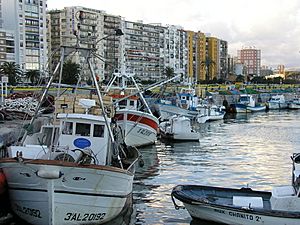
Fishing is a long-standing tradition on the Andalusian coasts. The region has Spain's second-largest fishing fleet and 38 fishing ports. Seafood like fried fish (pescaíto frito) and prawns are very popular. However, overfishing and pollution have caused problems for the fishing industry, leading to more aquaculture (fish farming).
Industry
Andalusia's industrial sector is relatively small. It mainly focuses on processing raw materials from agriculture and mining. Some important companies include those in the food industry, like Cruzcampo (beer) and Puleva (dairy). The aerospace sector is also growing, with companies like Airbus having a presence here.
Services and Tourism

The service sector has grown a lot in Andalusia and now makes up most of the region's economy. This includes tourism, retail, and transportation.
Andalusia is a very popular tourist destination, second only to Catalonia in Spain. It attracts nearly 30 million visitors each year.
Why Tourists Love Andalusia

- Sun and Sand: Andalusia is one of the sunniest and warmest places in Europe. Its beautiful beaches, especially on the Costa del Sol (Málaga) and Costa de la Luz (Huelva and Cádiz), are a huge draw.
- Nature Tourism: Inland areas offer stunning natural parks like Sierra Nevada, popular for skiing.
- Cultural Tourism: Andalusia has a rich history and many amazing cultural sites.
Famous Cultural Sites
Spain has seven UNESCO World Heritage Sites in Andalusia:
- Alhambra, Generalife and Albayzín in Granada (a stunning palace and garden complex).
- Antequera Dolmens Site (ancient burial mounds).
- 10th Century Caliphate City of Medina Azahara (ruins of a medieval city).
- Cathedral, Alcázar and Archivo de Indias in Seville (important historical buildings).
- Historic centre of Córdoba (famous for its Mosque-Cathedral).
- Renaissance Monumental Ensembles of Úbeda and Baeza (beautiful Renaissance towns).
- Rock Art of the Mediterranean Basin on the Iberian Peninsula (ancient cave paintings).
Andalusia is also the birthplace of famous painters like Velázquez and Picasso. You can visit the Museo Picasso Málaga to see some of Picasso's works.
Infrastructure
Good transportation and energy systems are vital for Andalusia.
Transport
Andalusia has a modern transport network.
- Public Transport: Cities like Córdoba, Granada, and Seville are improving their public transport, including metro systems and bike paths.
- Trains: High-speed AVE trains connect Madrid to Seville and Málaga, and also to Granada. This makes travel fast and easy.
- Roads: Major roads are modern highways (autovías) that connect cities across the region and to the rest of Spain.
- Airports: Andalusia has six public airports. Málaga Airport is the busiest, handling most international flights. It connects Andalusia to many cities in Europe, North Africa, and even North America.
- Ports: Port of Algeciras is Spain's leading commercial port. Seville has the only commercial river port in Spain.
Energy
Andalusia relies on imported oil because it doesn't have many fossil fuels. However, it has great potential for renewable energy, especially wind energy and solar energy. The region is home to large solar power plants, like the PS10 solar power tower near Seville, which was Europe's largest when it opened. The Plataforma Solar de Almería is an important center for solar energy research.
Education and Healthcare

Education in Andalusia is free and required until age 16. After that, students can go to university or vocational schools. Andalusia has a long history of higher education, with several universities like the University of Granada.
The Andalusian Health Service manages most public healthcare in the region, providing services to its residents.
Science and Technology
Andalusia contributes a good amount to Spain's scientific research. Most research happens in public institutions. The government supports technology parks, like the Technological Park of Andalucia in Málaga, which help develop new technologies.
Media
Andalusia has its own media organizations, including TV, radio, and newspapers.
Public Television and Radio
The public broadcasting company, Radio y Televisión de Andalucía (RTVA), runs two regional TV channels, Canal Sur and Canal Sur 2. They also have four regional radio stations, including Canal Sur Radio and Canal Fiesta Radio.
Newspapers
Different newspapers are published for each province or major city in Andalusia. There isn't one single newspaper distributed across the entire region. However, national newspapers often have special sections for Andalusia.
Art and Culture
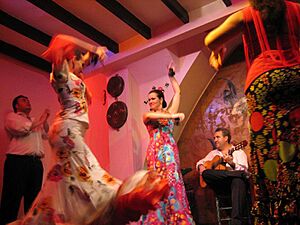
Andalusia's culture is a mix of its unique history and geography. Many different groups of people have lived here over time, including Iberians, Phoenicians, Romans, Germanic tribes, and Arabs. All of them have left their mark on Andalusian culture.
Arts
Andalusia has been the home of many famous artists:
- Painters: Velázquez, Murillo, and Pablo Picasso.
- Sculptors: Juan Martínez Montañés and Alonso Cano.
- Musicians: The composer Manuel de Falla, flamenco guitar legend Paco de Lucia, and classical guitarist Andrés Segovia.
Architecture
Andalusia has amazing architecture from different periods. You can see ancient megaliths (large stone structures) and Roman ruins like Italica.
The region is especially famous for its Islamic and Moorish architecture. The Alhambra in Granada and the Mosque-Cathedral of Córdoba are stunning examples. Traditional Andalusian houses often have inner courtyards (patios) and are painted white to stay cool.
After the Christian reconquest, new styles emerged. The Renaissance buildings in Úbeda and Baeza are UNESCO World Heritage Sites.
Sculpture and Painting
Andalusia has a long history of sculpture, from ancient Iberian carvings to Roman statues. The Sevillian and Granadan schools of sculpture focused on religious art, creating beautiful wooden altarpieces.
In painting, the Sevillian school produced famous artists like Velázquez and Murillo. There's also a style called costumbrismo andaluz that shows traditional Andalusian life, including bullfighting scenes.
Literature and Philosophy
Andalusia has contributed greatly to Spanish literature. Before Spanish, there was literature written in Arabic and Hebrew. In 1492, Antonio de Nebrija published the first grammar book for the Spanish language.
Many famous Spanish writers and poets came from Andalusia, including Luis de Góngora, Gustavo Adolfo Bécquer, and Federico García Lorca.
Music of Andalusia

Music is a huge part of Andalusian culture.
Flamenco
Flamenco is perhaps the most famous Andalusian music and dance style. It started in the 18th century and was heavily influenced by the Romani people (Gypsies). Flamenco includes singing (cante flamenco), guitar playing (toque flamenco), and dancing (baile flamenco). It's so important that the Andalusian government has laws to protect and promote it.
Other Music
Andalusia has produced many other great musicians, from classical composers to rock bands. The duo Los del Río from Dos Hermanas had international success with their song "Macarena."
Film
Andalusia has often been shown in films using stereotypes like flamenco dancers and bullfighters. However, the region has a growing film industry. Many films, documentaries, and TV shows are filmed here. The Málaga Spanish Film Festival is an important event dedicated to Spanish cinema.
Culture and Traditions
Customs and Society
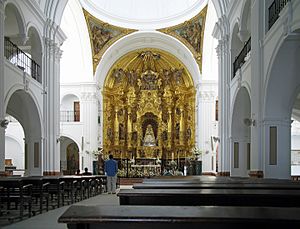
Andalusia has many unique customs, often blending Catholic traditions with local folklore. Traditional costumes are worn at festivals and bullfights. The Romería de El Rocío is a huge annual pilgrimage where about a million people visit a hermitage to honor the Virgin Mary.
During Holy Week (Semana Santa), religious groups carry large floats with sculptures of religious scenes through the streets. Sevillanas are popular folk songs and dances performed at fairs and festivals.
Andalusian Spanish
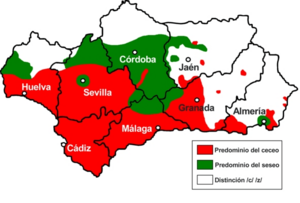
Andalusian Spanish is one of the most common forms of Spanish spoken in Spain. It has influenced Spanish spoken in the Americas. It has some unique features, including more Arabic words than other Spanish dialects and different ways of pronouncing certain sounds.
Religion
Roman Catholicism is the main religion in Andalusia. The region is known as "the land of Most Holy Mary" because of its strong devotion to the Virgin Mary. Holy Week processions, with thousands of participants, are a major tradition.
Bullfighting
Bullfighting has deep roots in Andalusia, with its origins tracing back to the 15th and 16th centuries. The region is still a center for raising fighting bulls and for bullfighting events. The oldest bullring still in use in Spain is in Ronda, built in 1784.
Festivals
Andalusia is famous for its lively festivals, which showcase traditional arts and costumes. Some of the most well-known include:
- Seville Fair (Feria de Abril) in Seville.
- Feria de Agosto in Málaga.
- Feria de Jerez (Horse Fair) in Jerez.
- The Carnival of Cádiz, known for its humor and music.
- The Fiesta de las Cruces (Festival of the Crosses) in Granada and Córdoba.
Cuisine
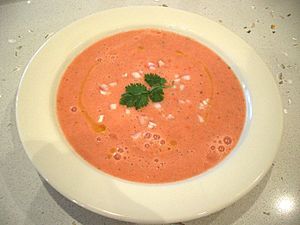
Andalusian food is part of the Mediterranean diet, using lots of olive oil, vegetables, fish, and meat.
- Seafood: On the coast, fried fish (pescaíto frito) and seafood are very popular.
- Meats: Mountain regions produce famous cured hams, like jamón serrano and the more expensive jamón ibérico from Black Iberian pigs.
- Sweets: Andalusia is known for its sweets made with almonds and honey, often made by nuns in convents.
- Soups: Cold soups like gazpacho and salmorejo are very popular, especially in summer.
- Wines: Andalusian wines are famous worldwide, especially sherry from Jerez de la Frontera.
Sports
Team Sports
Football is the most popular sport in Andalusia, just like in the rest of Spain. The oldest football club in Spain, Recreativo de Huelva, was founded here in 1889 by British workers.
Several Andalusian clubs play in Spain's top football league, La Liga, including Cádiz CF, Real Betis, Sevilla FC, Granada CF and UD Almería.
Basketball has also become popular, with teams like CB Málaga (Unicaja Málaga) competing at a high level.
Olympics

Many Andalusian athletes have competed in the Olympic Games. They have won several medals in sports like boxing, sailing, and racewalking. Seville has tried to host the Summer Olympics, and Granada has tried for the Winter Olympics, but neither has been chosen yet. However, Granada did host the Alpine World Ski Championships in 1996.
Other Sports
Andalusia hosts various other sporting events, including:
- Surfing, kitesurfing, and windsurfing competitions in Tarifa.
- Golf tournaments along the coast.
- Horse racing and polo.
- The annual Vuelta a Andalucía bicycle race.
- The Spanish motorcycle Grand Prix at the Circuito de Jerez.
See Also
 In Spanish: Andalucía para niños
In Spanish: Andalucía para niños
- Andalusian people
- Andalusian nationalism
- Azulejo
- List of Andalusians
- List of the oldest mosques
- Roman Bética Route
- San Juan De Los Terreros
- White Towns of Andalusia
- Yeseria
Images for kids



